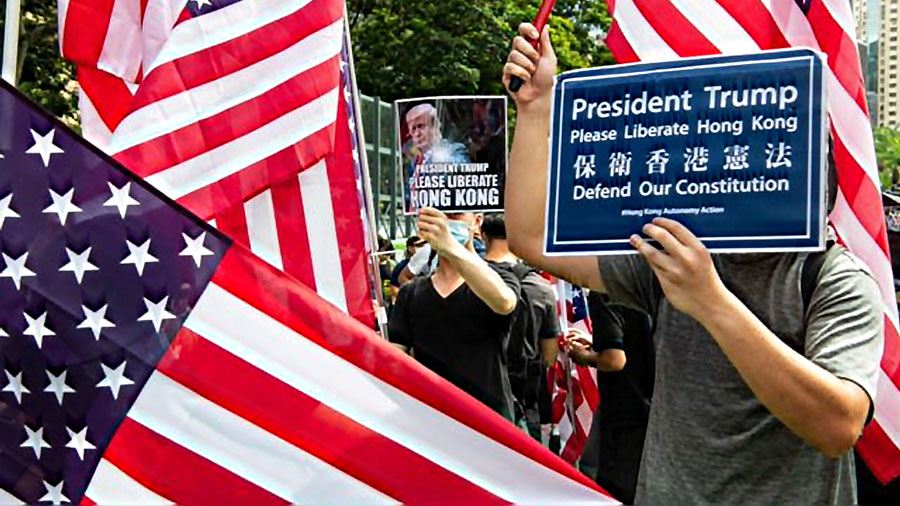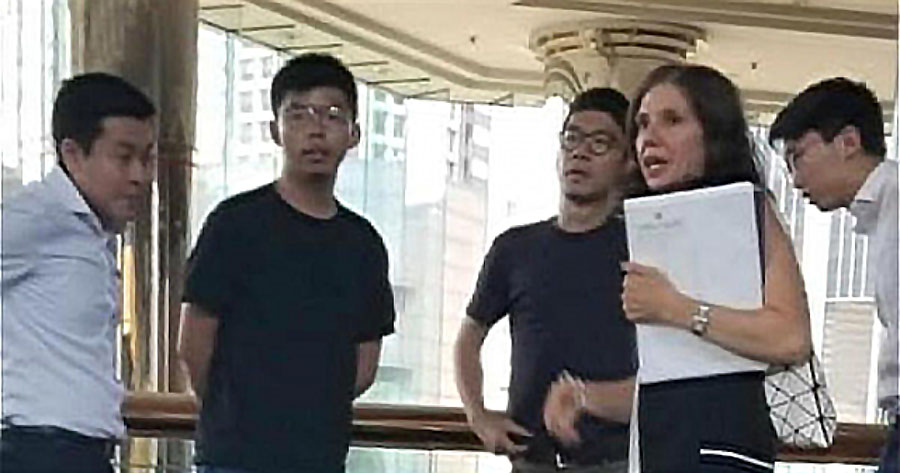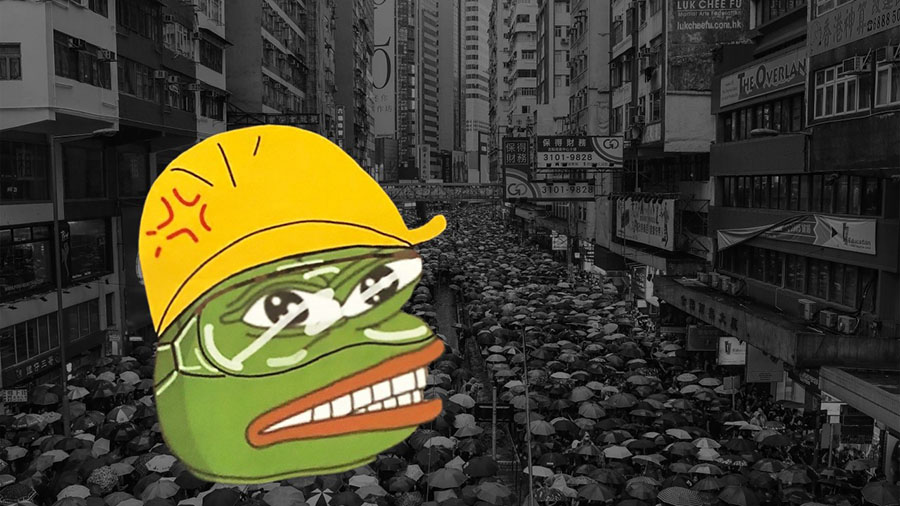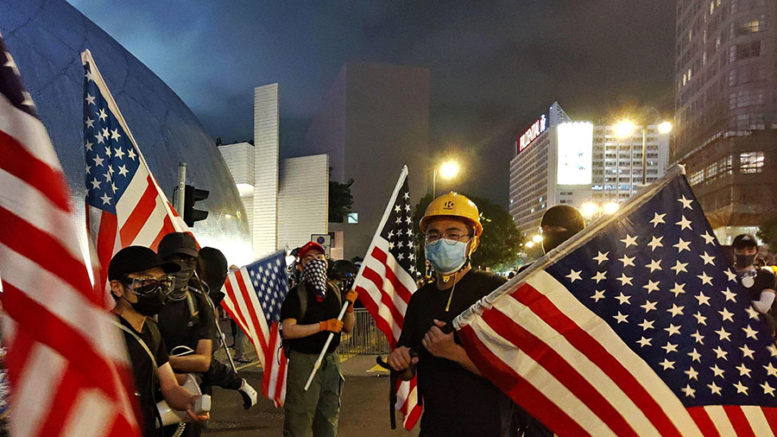Contributed by Joe Montero
When it comes to assessing a situation, it is wise to be careful and seek out the facts. This especially applies to events occurring overseas. They may not be as they first appear.
A good case in point is the protest movement in Hongkong. If we believe the hype, this is a movement fighting for democracy and standing against a bully neighbour. Those who accept this narrative on faced value, show their ignorance of history and contemporary events.
On the record, is the reality that China went through the Japanese occupation of World war Two and a subsequent civil war, which propelled the Communist Party of China into government and the transformation of the nation in 1949.

Many of those who were on the losing side fled to Hongkong and continued the battle from exile, against what they considered the Communist demon. This has been passed down through the generations.
Whether one believes the rise of the communists is good for China or not or not is not the point. The reality is that China is a sovereign nation and its political nature is not up to outsiders.
Unification was never going to be an easy marriage.
Then comes the role of the British, who after the first Opium War had taken Hong Kong by military force in 1840. The territory was run as a military garrison and remained under the direct rule of the governor until shortly before the hand back to China in 1997.
For most of this time, political parties and trade unions were illegal. Anybody carrying the tag of a communist was not allowed to work in a government job, and in practice, excluded from other jobs as well. Society was under martial law; unions were illegal, and disobedience was put down ruthlessly and could invite the death penalty. There was no such thing as elections.
Under the brutal reign of the British, Hongkong was developed into the financial hub of Asia, and a section of the local population prospered to become the core of the middle class and very wealthy in the colony. They had a stake in the the British presence and later an interest in returning to it as much as possible. The émigrés from China and their descendants are well represented in this demographic.
Meanwhile, the rest of the population remained seriously poor, surviving as a source of cheap labour. Many lived in humpies of scraps of wood and iron. ]
Only when British colonial rule was about to go and Hongkong return to China, did its beneficiaries discover that they were defenders of democracy. They had no problem about the absence of a parliament, the vote and the suppression of basic human rights under the British.
This is the major social base of the present movement for democracy in Hongkong.
The Britsh knew that whoever controlled the colony, controlled a very important deep-water port and the world’s number one shipping trade route, which happens to be the South China Sea. These were never going to be given up so easily.

Another important factor is that the former colonial power has been a master in maintaining its influence over former colonies by shifting form oveert to covert methods, and Hong Kong is no exception.
A combination of more than a century and a half of colonialism, a sizeable Hongkong political opposition, and other effects of the differences that became entrenched over time, eventually led to the One Nation Two Systems agreement. This is written under what is known as the Basic Law. Under it, Hongkong was recognised as part of China and the process of reintegration began.
Britain and the world agreed to this. It was voted for by the residents of Hong Kong.
The Basic Law spelt out that the two systems would phase out by the end of 50 years, when the process of integration is supposed to be completed. Now that the halfway marked has new been reached and passed, China seeks to proceed under the terms of the agreement, and this is what the the opposition, backed by the United Kingdom and United States wants to stop.
But this intention is hidden behind a beat up over a proposed extradition law.
It came after Taiwan complained over the escape to Hongkong of a young man wanted for the murder of his girlfriend. Because national law still does not have jurisdiction with this part of China’s own territory, the request by Taiwan for extradition could not be met. The new law is an effort to remedy this.
Although all nations are allowed the right for national law to prevail over regional and local law within the same country, an exception has been made for China. When other practice it is democracy at work. When China does the same, it is called undemocratic.
This double standard is enough to make it clear that this is not the real issue.
The protest movement is designed to cause economic damage and social instability, to create conditions to realise the breakaway of Hongkong. It has no chance of succeeding without outside intervention, which is an aim of the protest movement.
Why else carry and give special place to American flags?

Preparations had been made for this well in advance.
Even before signing the Basic Law, Britain was busy funneling support to certain organisations and political parties. The United States has now taken the primary role in this.
The Hong Kong Civic, Labor and Democratic parties are heavily financed by the US Congress, through funds funneled in through the US National Endowment for Democracy (NED). More money has gone to support various Christian churches and non-government organisations to create an extensive network.
Funding from NED is joined by more coming from the Ford, Rockefeller and Soros foundations.
NED Money has gone to fund the trade union organisation going by the name of the Hong Kong Confederation of Trade Unions (HKCTU), which was established in 1990, and exists in opposition to the main union movement, the Hongkong Federation of Trade Unions (HKFTU).
The older movement bigger and older union movement has a history of operating under the difficult conditions of illegality, and was behind the unrest that brought the colonial administration to its knees in the 1967.
The HKCTU gives its support to the protests. The HKFTU does not.
The political parties funded this way founded and dominate the Hongkong Human Rights Movement, which is behind the current protests, operating through the Civil Human Rights Front. And yes, the Hongkong Human Rights Movement also is directly funded by NED.
Consider Jimmy Chan, who is the head of the Front and its best known spokesperson. He is a US citizen and is openly promoted by close ally of the United States and Hong Kong’s version Rupert Murdoch, Jimmy Lai. Lai has personally donated $28 million to the Civic and Democratic parties.
Two other leaders, Steve Kwok the leader of the Labor Party and Alvin Yeung, leader of Civic Party, recently met with US officials to discuss the situation in Hongkong.
Kwok is also a member of the so-called Left 21 group and has been accused of travelling overseas a few times, as the guest of the US National Security Council. He is an open advocate of direct US involvement and the complete independence of Hongkong.
Not much more than a week ago, US consular officials were caught red handed, meeting with protest leaders in a Hongkong hotel. This has even been admitted in American media.

Video by CGTN America
In the face of this evidence, the Chinese complaints about foreign interference are well founded.
the protest movement also uses racism as a political weapon, suggesting that Mandarin speaking Han and other ethnic groups should not be allowed into Hong Kong and those who are there made to leave. This theme is represented by the frog image, which is a symbol for racial purity.

Support by foreign governments and other bodies on the scale that is evident would not be given without there being a clear intended goal. This goal seems to be to achieve the break-away of Hongkong.
This cannot be achieved without intervention. Although the turnouts have been big, and this is something for China to consider, there is no evidence that there is enough support form Hongkong’s 11.3 million population. Nor is this likely to change in the foreseeable future.
It is plausible to suggest that the purpose is to provoke China into cracking down on the protests and create a situation to do just this.
An explanation would be incomplete without mentioning that there is some disquiet over the declining fortunes. As China has risen economically, jobs have been created and wages and living conditions overall have risen by a long way.
Take the example of Shenzhen just across the border to the mainland. It has been transformed from a poor and dirty city, reliant on old labour intensive industries, into a high-tech hub of 20 million with high wages and transformed from a dirty city, to one of the greenest and most livable ones in the whole of China.
In Hongkong, it has been different. Jobs are falling and wages are stagnant. The cost of housing has risen steeply. The city’s position as the financial hub of Asia has been taken over by Shanghai. Many Hong Kongers want something done to improve the situation.
The catch is that for as long as integration is not complete, there is a great deal that Beijing can do about it.
And it comes about when Washington needs a distraction from policy failures with Venezuela, Iran and the whole Persian Gulf and Middle East, Korea, and Crimea, to name the main ones.
Finally, the events in Hongkong fit into the broader strategic picture and are directly linked into the diplomatic war against and sanctions against China, and the tension over the South China Sea.
Those who may still not want to know what has been revealed here should consider why are people like Donald Trump and former Australian prime minister John Hoard so loud with their praises?


The HK troubles have the brand of the CIA & the USA all over them. It is another attempt by the USA to subvert China in the same way as they have been doing in the Middle East and prior to that in Vietnam and so many other places over the last 100 years or so. Following WW2 they ramped up the USA interference in foreign countries rapidly and are now at extreme levels.
In reality, the USA is the worlds biggest terrorist nation, closely followed by Israel.
Seek out the facts – um, Hong Kong’s 25 million population. Hilarious you got that wrong. Important as their population of 7 odd million indicates the feeling behind a march that can pull 2 million. The writer knows nothing of the deep fears Hong Kong people have for Big Brother totalitarianism. The left needs a hero – fair enough- but let it be someone like Bernie Sanders. Serious fantasy and delusion at play in underestimating China’s Big Brother State potential.
Glen should check. There was population error in the article that has been corrected. It is 11.4 million including the New Territories with the city proper. They say the population is much bigger than stated on the record. There is dispute, given the rapid increase in the number of migrants form mainland China in recent years. Glen also fails to understand that this is not about right and left or the politics of Beijing. The world, including Australia says that Hongkong is part of China. The people of Hongkong voted for re-unification. It has only been separate when a colony of Britain. Organisations involved in the protests are funded by the United states government. What would Glen say if some people in a part of Australia wanted to break away and they asked a foreign government to invade? Glen should come clean on this, instead of hiding behind his own political narrowness. Having said this, there is no denying that the protests have involved a lot of people. The two million figure comes form the media. Organisers of the protest put it up to 1.7 million. Others have put it at less. Whichever claim is right, it is still a lot p=of people. China must consider this. I know the landscape of Hongkong. I have been there more than once. There has long been a serious political division on the population there. The biggest part has a history of supporting unity and have consistently voted for it. The biggest political parties, union federation and most community organisations and churches support unity. Their strength is based on the average working man and woman. I should also point out that there is no evidence of totalitarian big brother. It is quite relaxed and people can do fairly much as they like. By the way, it is no different in the mainland. I have been there two on more than one occasion.There is a considerable expatriate Australian population living there. They don’t seem to find too many problems either. It is also becoming one of the most must see destinations in the world. Again, this is not about political prejudice but stating it as it is. Glen should go there one day and have a look. He would be surprised.
Basically sound ideas in this article. The NED and other NGO’s interference is well know (and welcomed by some). I don’t remember anybody voting for anything concerning the Basic Law– the population was never consulted in that way. The brutal nature of British rule had softened by 1997 but democracy had not been introduced due to the UK’s far of loss of control. The population of HK is about 7.6 million only, but there are many visitors. As for “China’s Big Brother State”, it is hardly more Big Brother than the US. It does lack the farce of choice which the “democratic’ Western nations boast, but that is not a bad thing. China has developed faster than any country and lifted more out of poverty than any other country, whilst poverty increases in the West. The sad thing is that many of the population of Hong Kong know very little about China either.